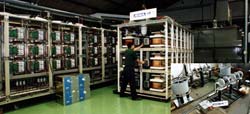This topic covers issues related to energy generation, conversion, transportation and consumption and how the industry is addressing the challenge of energy efficiency in general.
innovations-report provides in-depth and informative reports and articles on subjects ranging from wind energy, fuel cell technology, solar energy, geothermal energy, petroleum, gas, nuclear engineering, alternative energy and energy efficiency to fusion, hydrogen and superconductor technologies.

NSF ’sugar’ grant supports single-chamber prototype fed by wastewater
Something big may be brewing on the sewage treatment circuit thanks to a new design that puts bacteria on double-duty-treating wastewater and generating electricity at the same time.
The key is an innovative, single-chambered microbial fuel cell. The prototype is described in the online version of the journal Environmental Science & Technology (http://pubs.acs.org/journals/esthag/); the article w

OGI School of Science & Technology Research is one of a kind in Northwest
Oregon Health & Science University researchers have discovered a new way to accurately grow silicon nanowires on an electrode for use in fabricating transistors. A portion of these findings will be published in the Feb. 23 issue of Applied Physics Letter. The discovery has important implications for semiconductor research and may one day help engineers build faster computer chips.
A research group led

JEMA, the company based in Lasarte in the Basque Country, has recently put into operation the two energy supply plants designed and manufactured for the European EFDA (the European Fusion Development Agreement)-JET nuclear fusion experimental reactor at Culham in the United Kingdom. This reactor is one of the plants on which ITER, the largest research project in the world, has been based.
With this achievement JEMA has carried out more than 2 years of intense work in research, design and con

A Cornell University researcher is developing techniques for making photonic microchips — in which streams of electrons are replaced by beams of light — including ways to guide and bend light in air or a vacuum, to switch a beam of light on and off and to connect nanophotonic chips to optical fiber.
Michal Lipson, an assistant professor at Cornell, in Ithaca, N.Y., described recent research by the Nanophotonics Group in Cornell’s School of Electrical and Computer Engineering at the a

The first reactor capable of producing hydrogen from a renewable fuel source–ethanol–efficiently enough to hold economic potential has been invented by University of Minnesota engineers. When coupled with a hydrogen fuel cell, the unit–small enough to hold in your hand–could generate one kilowatt of power, almost enough to supply an average home, the researchers said. The technology is poised to remove the major stumbling block to the “hydrogen economy”: no free hydrogen exists, except what is ma

A proposed U.S. mission to investigate three ice-covered moons of Jupiter will demand fast-paced research, fabrication and realistic non-nuclear testing of a prototype nuclear reactor within two years, says a Los Alamos National Laboratory scientist.
The roots of this build and test effort have been under way at Los Alamos since the mid-1990s, said David Poston, leader of the Space Fission Power Team in Los Alamos’ Nuclear Design and Risk Analysis Group.
NASA proposes using u